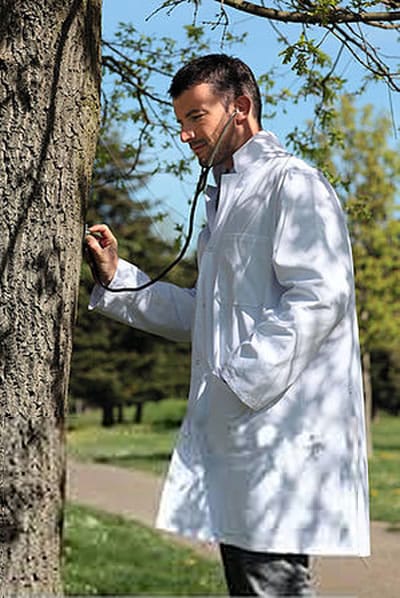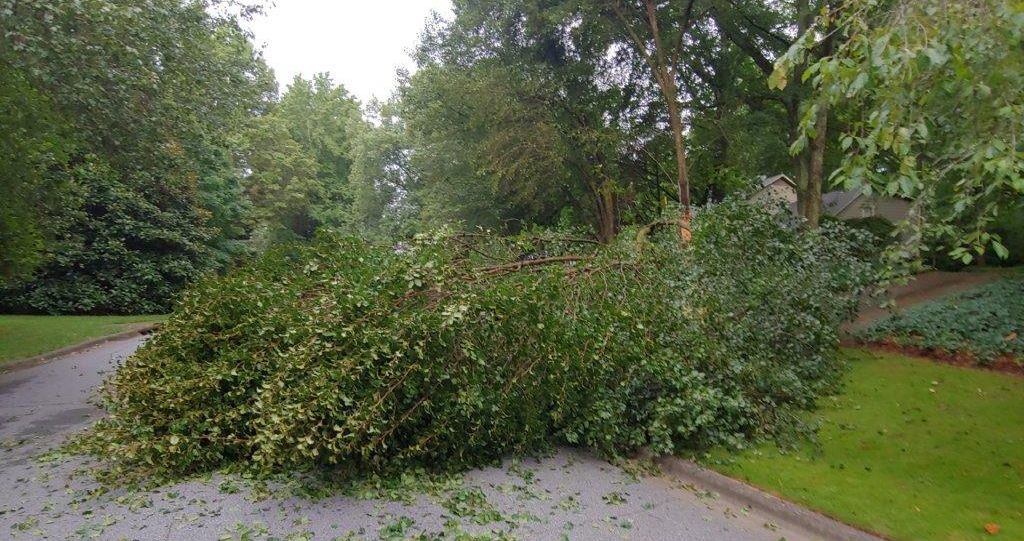We Offer All Types of Tree Care: Fertilization, Organic Soil Stimulants, Disease and Pest Control
Tree Fertilization
Fertilization is the addition of required nutrients necessary for trees and plants to thrive.
The nutrients in the soil fertilize the trees by a process called nutrient recycling where leaves and dead trees fall and decay. Bacteria in the soil colonize and various complex biological interactions occur. Too often people plant trees in the middle of their lawns where the fertilization processes for trees and grasses often compete against each other, thus inhibiting the health and growth of the trees.
The best time to fertilize is early spring, late March to early May, as well as fall during the first cooling in late September or when the fall pollen picks up. The recommended fertilizer should be spread evenly across the soil surface. The common fertilizers are: nitrogen (N), phosphorus (P) and potassium (K) or NPK for short.
The higher the number, the more concentrated the nutrient is in the fertilizer. For example, the numbers on fertilizer listed as 20-5-5 has four times more nitrogen in it than phosphorus and potassium…
Nitrogen (N) – is largely responsible for the growth of leaves on the plant.
Phosphorus (P) – is largely responsible for root growth, flower and fruit development.
Potassium (K) – is a nutrient that helps the overall functions of the plant perform correctly.
…if the fertilizer contains too much potassium and phosphorus, it creates excessive soil salts that trees may be unable to tolerate.

Let us give you an honest assessment of your tree’s health: 770-394-0905
Organic Soil Stimulants
Over time, soils in the urban environment become depleted of organic debris and can often also become compacted and even wash away. Organic debris is a critical fuel to the microbes that aid the tree in maintaining good health. Bio-root stimulants are mixtures of organic compounds which are beneficial to the bacteria and are added to the soil in a water suspension.
Healthy soils are teeming with life, from the giant work horses we know as earth worms to the microscopic single cell bacteria. This range in species is known as biodiversity. Health is measured in not just biodiversity but also in the quantity of organisms within each species, Such as the number of earthworms per cubic foot of soil. These organisms require a healthy home to maintain their numbers and overall diversity. Our urban soils lack the healthy home environment because of the limited supply of air, water, minerals, nutrients, and organic matter. Organic soil stimulants are water, air, minerals, nutrients, organic matter and in some cases living organisms.
Liquid soil stimulants are of the highest quality and behave similarly to natural nutrient recycling. This product is applied using specialized soil injection equipment. A small amount of stimulant is pumped from a tank into the ground under the tree canopy. This is repeated, spacing the injection sites about three feet apart, to form a grid under the entire tree canopy.
Disease Control
Diseases are just as common in the plant world as they are in the animal. Most of the time there is no need to treat your trees, however, things can get out of hand in a hurry. The treatments are as varied as the diseases themselves.
Trees are susceptible to numerous disorders caused by bad bacteria, fungi, and viruses. These organisms can attack trees through the roots, bark, and leaves. The causes for the disorders are a numerous as the types of organisms that cause them. However, the most common causes are the environment; lack of water, too much water, poor drainage, soils are compacted, nutrients are not available, not enough sunlight, too much sunlight, too cold, or too hot. it is necessary to determine the exact disease or disease complex before a treatment plan is developed. Our treatment plans may include chemical applications, watering or drainage plans, pruning recommendations, other cultural changes.
Pest Control
Pests are insects, mites, nematodes or any animal that is unwanted and harms the natural balance of a tree and its environment. Some insects and mites are needed and useful to a tree (bees are needed for pollination and the like.) Trees can also withstand some dangerous insects if the populations are low. Arborists refer to the numbers of a pest as the pressure. A low pest pressure is tolerable and requires no action. Moderate pressure is tolerable over a short period of time and requires no action. High pest pressures cannot be tolerated and cause the decline of the tree in a short period of time.
Pest management is the practice of keeping the natural balance of the environment. In cases of high pest pressure or if high pest pressure is predicted it warrants the use of pesticides. At every opportunity we apply chemicals that are low toxicity to mammals and as specific to the target pest as possible. By targeting the pest, we attempt to allow the good insects and mites to retain adequate populations so that they may help keep the bad insects and mites under natural control. Over time this practice should lead to a reduced quantity of pesticides in our environment.
We can treat for just about every insect and mite your trees may have. Most of the time there is no need to treat your trees, however, things can get out of hand in a hurry. The treatment methods and pesticides are as varied as the pests themselves. Applications may be made to the soil, to the leaves, to the trunk’s surface, and even injected directly to the tree’s vascular system.
Our Professional Tree Services
Click on one of our Tree Services to learn more about how we can help you with your tree needs
Free Tree Analysis:
We offer a free consultation to you when considering tree removal. Our qualified field representatives have the training necessary to determine if your tree is dead, declining, hazardous, need just trimming or nothing at all.
